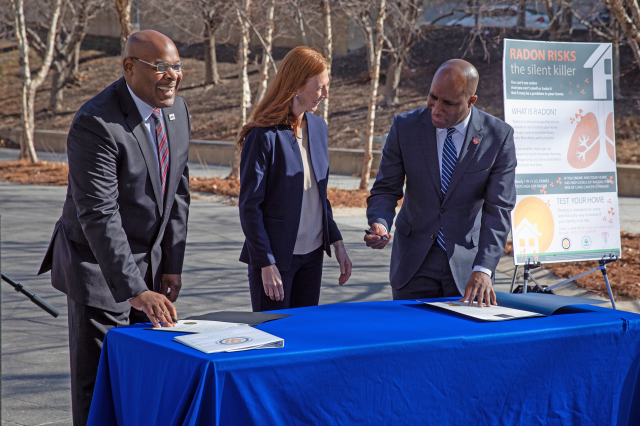KCK and KCMO Mayors Join EPA to Fight Radon Exposure
21,000 people die from cancer caused by radon exposure each year in U.S.
LENEXA, KAN. (MARCH 16, 2022) - EPA Region 7 Administrator Meg McCollister joined Kansas City, Kansas, Mayor and CEO Tyrone Garner and Kansas City, Missouri, Mayor Quinton Lucas for a special proclamation signing to fight radon exposure and to encourage all citizens to test their homes regularly for the presence of radon.
The special ceremony was held on Wednesday, March 16, at Ilius W. Davis Park, 11th and Oak Street, across from City Hall, Kansas City, Missouri.
Kansas City, Kansas, and Kansas City, Missouri, are both in EPA Radon Zone One, meaning that both cities have the highest potential to have homes test higher than the recommended radon level assigned by EPA.
“This event today is a significant step forward as we work together to limit unnecessary radiation exposure and achieve healthier indoor air quality in homes, especially for vulnerable populations, said McCollister. “We are working with communities to enhance and leverage EPA funding for states to reduce exposure to radon through home testing and mitigation.”
With the signing, the cities of Kansas City, Kansas, and Kansas City, Missouri, are encouraging the placement of EPA radon posters in city buildings to raise awareness of the cancer risks of radon exposure.
This partnership also challenges local hospitals and medical health networks in the Kansas City metropolitan area to place EPA radon posters in their medical buildings, waiting rooms, and exam rooms to help raise awareness of the importance of radon testing and mitigation to help prevent lung cancer caused by radon exposure.
Radon is the leading cause of lung cancer for non-smokers and is responsible for 21,000 deaths in the U.S. every year. In Kansas and Missouri, one in four homes have elevated levels of radon. The only way to know if your home has elevated levels of radon is to test it. EPA recommends that homes apply some level of mitigation if the radon level is 4 pCi/L (picocuries per liter) or more. Learn more on EPA’s website.
# # #
Learn more about EPA Region 7
View all Region 7 news releases
Connect with EPA Region 7 on Facebook: www.facebook.com/eparegion7
Follow us on Twitter: @EPARegion7

